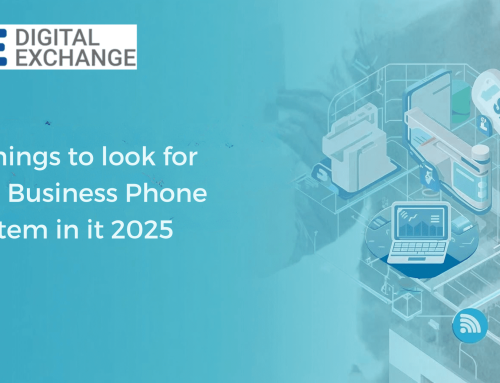In an era where seamless communication is the lifeblood of business, relying on outdated technology is no longer an option. With traditional phone lines, such as ISDN and analogue networks, being phased out by 2027, businesses must adapt to the changing landscape. A Voice over Internet Protocol (VoIP) phone system, powered by a stable internet connection, is a flexible, cost-effective and feature-rich alternative to business communications.
This guide will walk you through the process of building a reliable business communication system using VoIP and broadband. We’ll cover everything from the core benefits and key features to a step-by-step setup guide and best practices for quality and security.
What is a VoIP Phone System?
A VoIP phone system is a technology that enables you to make and receive calls over the internet, rather than through traditional phone lines. Voice over Internet Protocol converts your voice into digital data packets and sends them across your broadband internet connection. This digital method is more flexible and scalable, making it perfect for modern businesses.
Unlike traditional phone systems that require physical on-site hardware, most VoIP solutions are cloud-based. This means a VoIP provider manages the technical infrastructure, so you don’t have to worry about maintenance and complex setups.
Traditional Phone Systems vs. VoIP: What’s the difference?
The primary difference lies in the underlying technology. Traditional phone services utilise the Public Switched Telephone Network (PSTN), a network of copper wires that has remained essentially unchanged for decades. This is rigid, expensive to maintain and lacks the features businesses need today.
A VoIP system uses your existing internet connection to transmit voice data. This means no separate phone lines and a world of advanced communication tools, from video conferencing to CRM integration. The transition from analogue to digital is a fundamental shift that enables businesses to become more agile and efficient.
Why Your Business Should Switch to a VoIP System
Switching to a VoIP phone system offers numerous benefits that extend beyond simply future-proofing your communications. The benefits impact your bottom line, productivity and customer satisfaction.
Big Cost Savings
One of the primary reasons to adopt VoIP is the cost savings it offers. Businesses report reducing their communication costs by up to 50% or more. This is because VoIP eliminates line rentals and has much lower rates for international calls. Pricing is typically a per-user monthly fee, making it easier to budget.
Unparalleled Scalability and Flexibility
Businesses change. A VoIP phone system is scalable; you can add or remove users with a few clicks. Whether you’re a small business growing rapidly or a larger enterprise adjusting team sizes, the system adapts to you. This extends to remote and hybrid working, where employees can connect from anywhere with a stable internet connection.
Access to Advanced Features
VoIP phone systems come with advanced features that traditional phone systems can’t offer. These are designed to streamline workflows, improve customer service and team collaboration, and provide a unified communication platform.
Modern VoIP Phone System Features
Modern VoIP systems offer a range of powerful features that can transform your business.
Call Management and Routing
Call management is key. Features like call forwarding, call routing, and auto-attendants ensure that incoming calls are directed to the right person or department quickly. Reduces wait times and improves customer experience.
Enhanced Collaboration Tools
VoIP is more than just voice calls. Most systems include video conferencing and instant messaging. These tools help team members collaborate more effectively, regardless of location, and reduce the need for multiple disparate applications.
Integration with Business Software
One of the best features is CRM integration. Connecting your phone system to your Customer Relationship Management (CRM) software provides your team with valuable customer context during calls. This integration can automate data entry and improve customer satisfaction.
Mobility with Mobile Apps
Most VoIP providers offer mobile apps that enable smartphones to function as extensions of your business phone system. Employees can make and receive calls using their business number from their mobile devices, allowing them to stay connected on the go.
How to Set Up Your VoIP Phone System: A Step-by-Step Guide
Setting up a VoIP system is easier than you think. Here’s a simple guide to get you started.
Check Your Internet Connection
The foundation of any VoIP setup is a reliable internet connection. You’ll need enough bandwidth to handle your call volume. As a general rule, each concurrent VoIP call requires about 100 kbps of both upload and download speed. Run a speed test to make sure your broadband internet connection is up to the task.
Choose Your VoIP Provider
Choosing the right VoIP provider is key. Look for a provider that offers the features your business needs, transparent pricing and excellent customer support. Read reviews and compare plans to find a service that fits your budget and operational requirements. Many VoIP providers specialise in solutions for small and medium businesses.
Select Your Hardware
You have options when it comes to hardware. You can use dedicated VoIP desk phones (also known as IP phones), which connect directly to your network. Or you can use softphones—software applications that run on a computer or mobile device—paired with a headset. If you want to use your existing traditional phone, an Analogue Telephone Adapter (ATA) can bridge the gap.
Configure Your System
Once you’ve signed up with a VoIP service, your provider will guide you through the configuration. This usually involves setting up your phone numbers, configuring call routing rules and customising features like your auto-attendant. For a cloud phone system, all of this is done through a user-friendly online portal.
Test and Train Your Team
Before going live, thoroughly test the system to ensure call quality is clear and all features are functioning as expected. Once you’re happy with the setup, train your staff on how to use the new system. Proper training ensures you get the most out of your investment and the transition is smooth for everyone.
VoIP for Small and Medium Businesses (SMBs)
VoIP is perfect for small and medium businesses. The low upfront cost and predictable monthly fees make it an affordable option. The ease of use and simple management mean you don’t need a dedicated IT team to manage your phone system. The scalability means the system can grow with your business and enterprise features, without the enterprise price tag.
How to Ensure High Call Quality and Reliability
A common concern with VoIP is the quality of calls. However, with the proper setup, VoIP calls can be clearer than traditional phone calls.
Prioritise Voice Traffic with quality of service
To ensure high call quality, you can configure Quality of Service (QoS) on your router. Quality of service prioritises voice traffic over other data on your network, which minimises issues like latency and jitter. This ensures your voice data packets are delivered smoothly for uninterrupted communication.
Have a Backup System
For ultimate reliability, consider having a backup system in place. A secondary internet connection can provide failover if your primary line goes down. An Uninterruptible Power Supply (UPS) can keep your network equipment running during a power outage, and features like automatic call forwarding to mobile phones mean you never miss a call.
VoIP Security
Securing your VoIP communications is critical. Reputable VoIP providers utilise encryption protocols such as Transport Layer Security (TLS) and Secure Real-time Transport Protocol (SRTP) to safeguard your voice data from eavesdropping. Strong passwords, firewalls, and regular software updates are also essential components of a secure VoIP setup.
Get Ahead with VoIP
Building a business communication system with VoIP and broadband is a smart move that prepares your business for the future. By moving away from traditional phone lines, you gain a powerful, flexible, and cost-effective tool that boosts productivity and enhances customer service.
From significant cost savings and advanced features to seamless scalability, a VoIP phone system has everything a modern business needs to succeed. By selecting the right VoIP provider and adhering to best practices for setup and maintenance, you can establish a communication system that aligns with your business objectives and generates a positive return on investment.
Ready to get started? Find out how VoIP telephone systems can transform your business communications. Visit The Digital Group’s VoIP solutions page for more information and advice.







